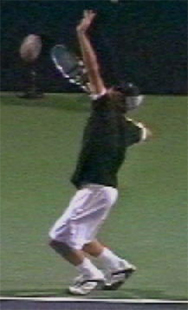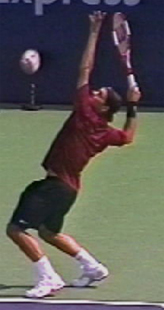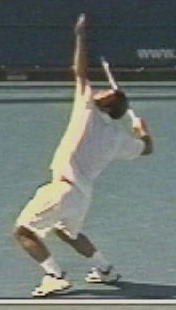
Roger Federer:
| |||||||||||||||||||||||||||||
The contact is just at the front edge of the body. |
Front to Back
There is one more important factor to consider in the placement of the toss. This is the position of the ball on the front to back axis. "Toss the ball in front of you for more power." That's another common mantra in teaching. But if we look at Federer, or any top server, we see that the contact point is barely in front of the body. If you draw a line straight down from the ball toward the court, it's roughly even with the edge of the player's face, or at most an inch or two further in front.
This makes perfect sense for a number or reasons. If the toss were significantly further in front, the player would have to reach forward with the racket. This would lower the contact point, decrease the margin of error crossing the net, and also make it more difficult to create topspin. There are other reasons the contact point is normally not as far in the court as is generally believed, which we'll discuss below when we discuss leg position.
Body Rotation
We've seen that the top players extend their tossing arms to the side and this affects the path of the toss. But why? What's the advantage of pointing the arm across the body? The answer is that the position of the tossing arm toward the sideline is related to the body turn away from the ball. This turn determines the forward body rotation in the motion. The stretch of the left arm across the body is actually similar to what happens in the preparation phase of the forehand. It creates and/or increases the shoulder turn and prepares the torso to uncoil into the shot.
Roger turns away from the ball around 60 degrees. |
When we look at Roger we can see that he has a substantial body turn. So the more turn, the more the tossing arm is likely to point sideways. As we have seen previously, the amount of turn is also related to the stance. Players naturally turn away from the net along the line of the stance. Watch Roger. His shoulders start roughly square to the net. As his tossing arm goes up, you can see his torso turn away from the ball, rotating back about 60 degrees. If you draw a diagonal line across the tips of Roger's toes, and another one across his shoulders, these lines will be roughly parallel. Imagine how awkward and restricted this move would appear if Roger was trying to point his tossing arm straight ahead at the same time.
Roger's turn is greater than Roddick's, but less than Pete Sampras's. And you can probably guess what I'm going to say next. His body turn is more reasonable for the average player to try to develop, assuming the basic elements of the swing are in place. It's reasonable, but you should probably start with an even less extreme version than Federer. You can do this by squaring the stance, or creating just a slight offset, and starting with your shoulders perpendicular to the net. From there you can gradually edge your rear foot behind you to your left. This will automatically increase the turn by changing the line along the edge of the toes.
 |
 |
 |
More turn than Roddick, less than Sampras |
||
The point of turning away from the ball, obviously, is to increase the amount of torso rotation forward into the hit. Watch Federer rotate into the ball in both the deuce court and the ad court. You can almost feel the extra energy that is going into the shot. The exact degrees of rotation, as well as the speed of the torso rotation, the differences in the angles of the hips and the shoulders, are all elements that contribute to the motion, and ultimately to racket speed, ball speed, and spin.
The amount of forward rotation and the exact angle at contact are natural conequences. |
Analyzing them precisely as well as their interrelationships is a fascinating
challenge that will undoubtedly increase our understanding the serve's bio-mechanics. The method
that will allow us to see these factors more clearly--as with so many others factors in technique--is
quantitative analysis. This is the work of Brian Gordon, Bruce Elliot and a few others, including Tennisplayer's own Greg Ryan. Working with Advanced Tennis, Greg has done 3-dimensional studies that we plan to report about on Tennisplayer.
The whole picture is very complex. But one belief about the torso rotation that is definitely inaccurate is the idea that the hips and shoulders should be open or parallel to the baseline at contact. Federer's shoulders and hips are at an angle to the baseline and somewhat closed, and this is the same for other top players, as we have seen in our analysis of Sampras and Roddick. We can also see that the torso is more closed in the ad court than in the deuce, something that makes sense when we consider the differences in path of the ball.
Platform stance, deep knee bend, left foot landing. |
Should the average player strive to control his body rotation to match Federer's angles? The interesting thing is that the torso tends to rotate into contact naturally and automatically. If the player sets up his stance and takes a relaxed backswing, the torso tends to naturally turn away from the ball along the line of the stance. Once the turn is complete, the rotation forward should just happen as an automatic part of the motion as the racket drops and goes up to the ball and the legs uncoil. Cause and effect again? Correct.
Sometimes you see players try to force the shoulders around and end up too open at contact. This can happend when players try to serve wide in the deuce court and intentionally rotate the shoulders trying to swing the ball wide.. This is also an issue with the pinpoint stance, in which the motion of the back leg can set the torso in motion and cause it to over rotate, or rotate too soon. Again, your goal should be to turn the torso onto the line of the stance during the backswing. Now key on the racket drop, the knee bend, the motion to the ball and the landing. You'll find that your torso will uncoil into the shot without further conscious effort.
As the arms drop Pete and Roger are standing with the weight evenly distributed. |
Leg Action
A major commonality in the serves of good players is the use of the legs--the deep knee bend and the front foot landing. This is another topic I've addressed in detail both in the Sampras series (Click Here) and in the articles on the great myths in instruction (Click Here.) There are also examples in the Stroke Archive of virtually every top server showing the knee bend, the uncoiling, and the left foot landing. As I have argued before, I think the platform stance is probably superior at the higher levels and is also much easier to master for the majority of players.
Federer is a great model here. The width of his feet in his stance is moderate, somewhat
narrower than Pete's. As the arms drop it's very natural for him to bend his knees and drop his weight
evenly between the feet. Like Pete, Federer keeps a lot of weight back on the rear foot as he knees
go down. As his arm starts up and approaches the ball release, it's almost if he is just standing
straight up and down with his weight balanced equally on each foot.
Great balance and posture at the deepest point in the knee bend. |
This leads naturally into the full knee bend in a platform hitting stance. As the ball
releases, Federer shifts more weight forward and his knees start to go down. The knee bend is quite
deep, with his upper leg at a 30 degree angle or more to his lower leg. This is the same or maybe a
little less than Sampras but more than some other great servers such as Rusedski whose knee bends are
limited by the pinpoint stance.
Look at Roger's balance at the deepest point of the bend. His weight has shifted forward but it definitely not completely on the front foot. His posture is still great He just looks balanced and strong. As we saw in the Sampras articles, the alleged "arch" of the back in this part of the motion is an illusion. As his knee bend deepens, the torso just naturally inclines backwards at an angle. But look how the hips and shoulders stay in line. Note also that the completion of the knee bend coincides quite closely with the point of maximum body turn away from the ball.
The leg drive from the front foot creates air. |
As the racket drops, the weight shift continues onto the front foot. Roger comes up on his back toes, and then his rear foot leaves the court. As we saw in our analysis of the stances, the majority of the push or drive in a platform stance is coming from the front leg. The rear foot is literally being pulled off the court. The leg drive off this front foot is very powerful. Look how far he explodes upward. That is definitely a lot of air. It is significantly more than Roddick or Pete, this is with the same or less knee bend. We noted that Roger's racket drop isn't quite as deep as these players, but he may be making up for it partially through the explosiveness of his legs.
Like virtually every top player, Federer lands on his left front foot. Watch how he actually lands partially on the baseline, although on other balls he may land a few inches inside the court. More on this below. As he lands, his right leg kicks back in the other direction. The lower leg comes up until it is at about parallel to the court or a little higher. Here, once again Roger takes the middle path. His kick back with the opposite leg is a little more than Sampras but less than Roddick.
The front foot landing with the back leg kicking back. |
Landing
As he gets up into the air look how beautifully he retains his posture! He is still almost completely straight up and down with his body in line from the tips of his shoes to the tip of his racket. It looks like he is defying gravity because he lifts off the court so easily.
Now watch Roger's incredible balance on his landing. Far and away Roger lands with the best posture of any of the top pros. Every player lands leaning forward to a certain extent, including Roger. But Roger is the closest to truly straight up and down. Body position and balance is critical on the landing is because of the speed of the ball in the modern game. The server hits a 130mph first serve and lands inside the court with one foot in the air. The returner rockets a 95mph return. How quickly can the server recover in order to hit the first ground stroke in the rally?
We saw above that Roger lands at most a few inches inside the court or even with his heel still on the baseline. He's almost completely upright which allows him to recover his balance, split, and better ready for the first ball.
What about that landing when it comes to the serve and volley? Isn't one of the basic precepts of serving to drive your weight into the ball and land as far forward into the court as possible to get to the net more quickly? I heard that a lot as a junior player. A tour player I know recently went to work on his serve and volley with a coach who was a former top 10 player in the world. The coach advised him to try get further into the court both at contact and at the landing, so he could get closer to the net. Out of curiosity I pulled some video of the coach in a pro tournament match and found that he himself landed only a few inches inside the line.
A balanced landing means that Roger is ready to play. |
If you look at Sampras, or Rusedski, you'll see the same. In the modern game, when the player's serve and volley they land on the front foot, take 1 or occasionally 2 more steps, then split step for the first volley. That's what puts the premium on the landing. You've probably heard that you should try to reach the service line to hit the first ball. But in pro tennis that doesn't happen. The top players are all hitting the first volley roughly half way between the baseline and service line. Ironically. a player like Roddick who never serves and volleys usually lands more inside the court--and more off balance--than players like Federer or Sampras.
Followthrough
Finally, let's take a look at the followthrough on Roger's motion. Again it's a great model because it is so natural, fluid, and relaxed. Watch how his arm continues to flow after the completion of the pronation, moving forward and then from the right back to the left. His racket hand passes in front of his left leg and then actually continues to move across his left side and upwards and behind him to about waist level. At that point Roger catches the racket with his left hand to begin his recovery to the ready position.
When Pete Sampras was at the top, a lot of players and coaches made a big deal out of the fact that at least on some serves, Pete seemed to finish on the right side of his body. That was actually quite rare, but it was true that his finish was shorter than most players, and that his racket hand tended to end up in line with his right leg, not his left. A lot of players tried to copy that right side finish without having the other elements that actually made it happen.These include an extreme left ball position,and the racket motion more directly forward and outward toward the net and less from left to right.
A full, flowing followthrough is definitely something to model. |
That finish is the exact opposite of Roger. Remember what we saw about Roger's ball position? His arm and racket move more from left to right. Because he is so relaxed his arm just naturally swings back across his body to the left. The followthrough is one more thing we can all learn from Roger. Most players are too tight all the way through the motion, including the finish. But it would be impossible to stay tense and make that finish position.
So that takes us all the way through Roger's service motion. It may not be as flashy as Andy Roddick. But you could certainly argue that it is as effective or more effective as part of his incredible all court game. That's a game we can all aspire to play at some level to a greater or lesser extent. And the serve is a good place to start.
|
Contact Tennisplayer directly: jyandell@tennisplayer.net
Copyright Tennisplayer 2005. All Rights Reserved.

